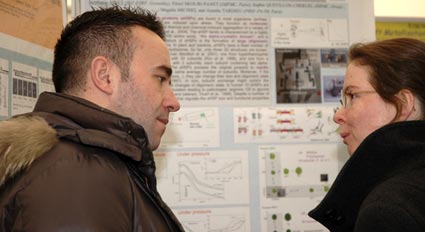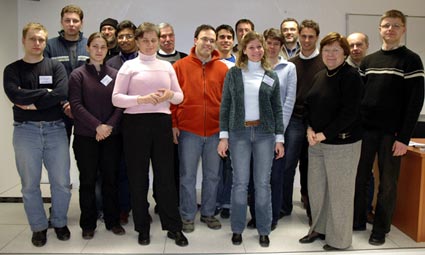- Home
- News
- General News
- Users get together...
Users get together for the ESRF annual meeting
06-03-2006
The sixteenth edition of the annual Users' Meeting was held on site at the ESRF during February 2006, and attracted 240 participants from 18 countries.
Share
|
After a review of the past year's activities on beamlines and the machine, W.G. Stirling and the Research Directors presented plans for the medium-to-long term strategy for the facility. They identified increasingly pressing requests for nanofocusing and nanotechnology on beamlines, for time-resolved experiments, for increased support for special sample environments, beamline automation, and increased capacity for imaging and materials science experiments as well as for biology and human health programs. Plans were presented for upgrades to the machine, and to 1/3 of the beamlines, for instrument and detector development, and an increase in computing capacity. A series of new long beamlines are projected, together with a re-construction of the experimental hall, to include additional laboratory and office space. Participants then broke out into parallel group discussions, to debate these proposals and define special needs in their particular areas. In a second session, the series of results presented by users were well received. This year again, a marquee was erected to house the posters and refreshments, and helped contribute to stimulating exchanges amongst visitors and ESRF staff members. |
|
The award of the 2006 Young Scientist prize went to Paul Tafforeau, for the application of X-ray synchrotron imaging to studies in paleontology. The next day, Paul Tafforeau presented his studies on ID19 and ID17, firstly of fossil teeth from a 35 million-year old primate, and inferences as to the primate's diet, and secondly the study of small fossil eggs and the imaging of the skeleton remaining inside the egg.
 |
The poster session encouraged discussions and perhaps future collaboration between the scientists. |
Workshop on Dynamical Phenomena in Soft Matter
The workshop, with 50 participants, discussed a broad range of issues in nano-scale dynamics studied by dynamic and real-time X-ray scattering, and complimentary techniques such as light and neutron scattering. The topics included equilibrium dynamics in the bulk, dynamics at surfaces and interfaces, out-of-equilibrium dynamics in shear flow, fast real-time kinetics above the diffusive range and finally nucleation and growth dynamics beyond the classical scenario.
 |
|
Break-time during the Dynamical Phenomena Workshop. |
During the session on bulk dynamics, the problems encountered when dealing with non-ergodic systems were extensively discussed. Non-exponential relaxation seems to be an ubiquitous feature of the slow dynamics in these complex systems. The cross-fertilization between dynamic X-ray scattering (XPCS) and light scattering (DLS) techniques has helped to address some of the longstanding issues in dynamics of these systems, for instance, concerning the universal ageing phenomena. Future advancement depends largely on the further development of fast, high resolution and low noise area detectors and rigorous data analysis methods. Application of XPCS in reflection or grazing incidence geometry is now an emerging technique to investigate the dynamics of surfaces and membranes. The two talks in this session discussed the recent advances in this area. The dispersion relation obtained by surface dynamics allows deduction of microscopic interfacial properties which are otherwise difficult to access experimentally. For the first time, true dynamic measurements allow discrimination between static, frozen-in disorder and dynamic features which is impossible by classical diffuse scattering methods.
The complexity of soft matter is more readily manifested in shear flows. The out-of-equilibrium dynamics session illustrated the complex relationship between microstructure and rheology in diverse systems, from interacting colloidal suspensions to highly self-assembled amphiphilic structures. The session on fast dynamics demonstrated the power of synchrotron scattering in probing nanoscale phase transitions in the nanosecond time scale by the pump-probe method and in investigation of the conditions and the rapid growth dynamics in dilute systems such as soot formation in flames. Finally, the workshop concluded with an discussion on some of the contentious issues in polymer crystallization, and a vivid presentation of the nucleation and growth dynamics of nanoparticles in solution and their multiscale organization.
Workshop on High Pressure and Synchrotron Radiation
| More than 100 researchers from all over the world assembled in February to review recent advances in science at high pressure at third generation synchrotron sources. Plenary talks introducing the main areas of high pressure research, earth science, material science and chemistry and hard condensed matter, were followed by shorter presentations focused on a variety of experiments using synchrotron-sourced techniques, including X-ray diffraction, absorption spectroscopy, inelastic X-ray scattering and Mössbauer spectroscopy. The state-of-the-art in these wide-ranging techniques and the rapid progress made in theoretical prediction and interpretation of experimental results was described. |
|
Third Synchrotron Radiation School for New ESRF Users
At the same time as the Users' meeting, a school dedicated to participants who have never carried out experiments at the ESRF and who are potential users was organised. Twenty seven people from eleven countries had registered. The goal of this school was to give the participants an overview of the many scientific opportunities at the ESRF beamlines. The first day of the school was common for all the participants and included general information about the ESRF, operation of the machine and general lectures on the use of synchrotron light for imaging, scattering, spectroscopy and diffraction experiments. In the second part of the school, illustrative examples were given of the science carried out at the ESRF together with visits to the beamlines. The participants were offered the possibility of following a more biology-oriented programme or a more physics-oriented programme.
 |
|
Participants and staff at the New Users Workshop. |





